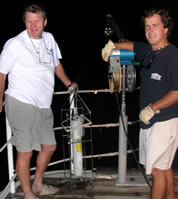| OCULINA Coral Banks |
Daily
At Sea Log |
Oct. 21, 2002 |  |
|
|
By: Rachel McEvers, Project Oceanica
You might be wondering what a typical day at
sea is like. Stacey Harter and Rachel McEvers are both "watch standers"
on the mission. Their shifts, as well as those of the other watch standers,
consist of two four-hour shifts with eight Fig. (A grumpy
scientist protests work before the sun comes up.) A typical day starts at 3:45 am when they are awakened
by a member of the crew. During their watch they make sure the data
is being received properly from the multi-beam and side-scan sonar devices.
There are numerous variables on the three computer screens that must
be recorded and maintained. Fig. (The sonar team watching their monitors intently (pictured right). Last night they found an uncharted 240 ft. sunken vessel!) 
CTD casts are necessary since temperature affects the speed of the
sound waves that are being sent by the sonar device. This information
will be used later when all the data gathered on the mission is processed.
The watch standers are in constant contact with the bridge, which is
the place where the captain and crew pilot the ship. They're supposed
to use proper radio code words like "roger" and "copy"
but sometimes they forget (oops)! Fig. (The CTD samples
the water to correct
for sound velocity every 4hours, or 20 miles.)
Rolando Herrera (pictured
left) is the cook on the M/V Liberty Star. The cook
is definitely one of the most important people on the ship. Prior to
joining the crew on the M/V Liberty Star, Rolando worked for
24 years in the Navy as a cook and 11 years in the Merchant Marine as
a steward. In the Navy, Rolando went to school for cooking and kitchen
management. He has been with the M/V Liberty Star for 6 years
now. Besides cooking, Rolando creates menus and does all the grocery
shopping, as well as helping keep the ship clean. The thing he likes
best about his job is the people. He says the crew on this ship is wonderful
and they are a fun bunch of guys. The only thing he doesn't like is
when they have rough seas. When I asked Rolando what kind of fish he
would be he answered immediately, redfish. |
| Ph. 843-953-7263 |
Project Oceanica Lowcountry Hall of Science and Math College of Charleston Charleston, SC 29424 |
Fax 843-953-7850 |